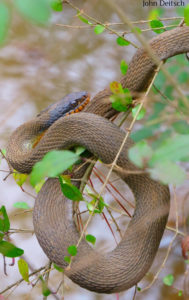
Photo was taken by John Deitsch at George Pierce Park
By: Ashlyn Halseth
As their name suggests, the red-bellied watersnake or Nerodia erythrogaster erythrogaster is a non-venomous snake, found in Georgia, that lives close to water! They are known for their distinctive keeled scales, that make them appear dull and raised off the snake’s body as opposed to smooth scales. When they are first born, juvenile red-bellied watersnakes have numerous dark stripes on their neck that fade into blotches as you reach the tail. This color pattern allows young watersnakes that aren’t adapted with venom, the ability to blend in, or camouflage into their environment to avoid predators. As they mature, the snakes’ colorful pattern will fade into a solid color on top, typically brown or grey. This coloration among water-dwelling snakes is common; however, the red-bellied watersnake has an unpatterned underside/belly that can range in color from pale yellow to bright orange that is unique to this species.
Another feature that distinguishes the red-bellied watersnake from other watersnakes, is how they respond to stress. When faced with danger, most watersnakes will take cover with the nearby body of water to avoid predation; but in the case of the red-bellied watersnake, they will often flee out of the water into nearby brush. If no cover is close, the snake will instead use mimicry to trick predators into thinking they are a venomous snake instead. They will coil up and strike at the nearby animals spreading foul-smelling musk instead of venom. While the musk will startle their attacker and their sharp fangs will pierce through the skin, the red-bellied watersnake will rarely harm something larger than itself and is protected under Georgia law.
As for prey species, the red-bellied water snake will consume almost anything smaller than itself, which averages about 30-48 inches in length. Due to their semi-aquatic habitat, the red-bellied watersnake will primarily consume amphibians and some species of fish. Because the red-bellied watersnake lives everywhere from northern Florida to Virginia, skipping mountainous areas, different biologists have observed different behavioral changes; however, in most locations, the following reigns true. Red-bellied water snakes are exothermic, meaning they rely on their environment to regulate their body temperature. Because of this, watersnakes will be inactive during the day, using this time to sunbathe and increase their internal body temperature and hunt at dawn and dusk.
Another interesting adaptation of the red-bellied water snake is the fact that they give live birth. Throughout the world, about 70% of snakes will be oviparous, meaning they lay eggs with their young inside giving them a chance to develop while consuming the yolk. But, because of environmental stressors, red-bellied watersnakes birth live young, similar to mammals, instead of laying eggs. This alteration in natural history allows the species to skip a phase of their life cycle that leaves them vulnerable. Eggs, without strict parental care, are easily washed away by flooding or consumed by predators. Without needing an egg for full development, the red-bellied watersnake is capable of laying 6 to 50 young every fall, all ready to fight with a small pair of fangs.
Sources:
Rogers, Emily. Willson, JD. “Red-bellied Watersnake (Nerodia erthrogaster).” Savannah River Ecology Laboratory. Accessed August 20, 2020. https://srelherp.uga.edu/snakes/nerery.htm
“Red-bellied Watersnake.” Amphibians and Reptiles of North Carolina. Accessed August 20, 2020. http://herpsofnc.org/red-bellied-watersnake/
“Redbelly Water Snake” Florida Museum. Accessed August 20, 2020. https://www.floridamuseum.ufl.edu/herpetology/fl-snakes/list/nerodia-e-erythrogaster/
Bradford, Alina. “Snake Facts & Types of Snakes.” Live Science. Accessed August 20, 2020. https://www.livescience.com/27845-snakes.html#:~:text=Snake%20eggs%20%26%20baby%20snakes&text=About%2070%20percent%20of%20snakes,climates%20do%20not%20lay%20eggs.

Recent Comments